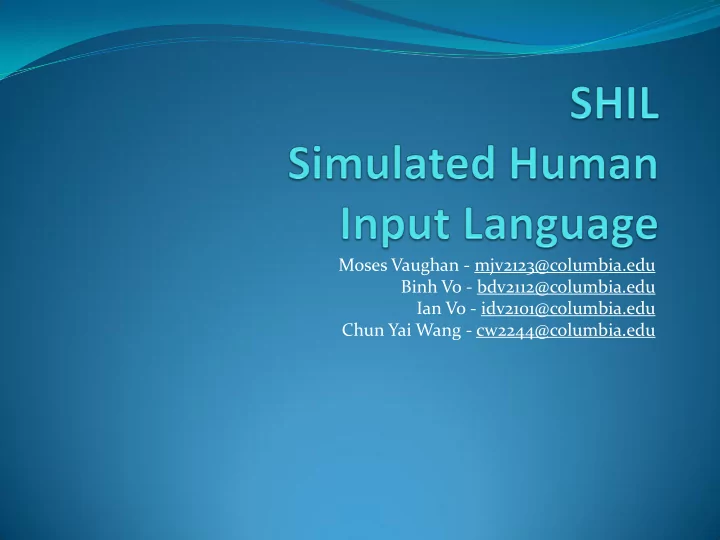

Moses Vaughan - mjv2123@columbia.edu Binh Vo - bdv2112@columbia.edu Ian Vo - idv2101@columbia.edu Chun Yai Wang - cw2244@columbia.edu
Why SHIL? SHIL is a language used primarily for developing HTML based automated bots. Provides the developer with tools to represent web interactions. With these tools users can write applications that automate a variety of site interactions. Manipulating look & feel of a given site. Ability to write bots/spammers. DataMining.
Perspectives User SHIL can be used to implement command line user interfaces. Useful for writing shell scripts that make use of website functionality . Server SHIL can be used to simulate user interaction by with automating server interaction . Useful for many applications ranging from creating spiders to website test scripts.
Tutorial – The Basics I Comments: The usual /* and */ are used for all comments. Assignment : The arrow points the way. ‘< - ’ a <- 4; Comparison: Single Equals ‘=‘ “ asdf ” = “ asdf ” Functions : Use the “function” keyword using the template. function functName(<type> <var>, <type> <var>) -> <return type> {<body>} Ex/ function add(integer a, integer b) -> integer{ return a + b;} Function Call: result <- func_name(arg1, arg2);
Keywords integer real boolean function map array If while foreach break end fun use return TRUE FALSE maybe string
Operators Lexeme Usage <- assignment + - / * math " string** ; statement termination . struct reference [ ] array reference ( ) Logical grouping & | ! = < > >= Boolean Operators
Data Types SHIL uses the usual suspects. Integer Boolean Map Array String Real – Acts as a floating point number
“Hello World!” in SHIL Control Flow resembles that of a scripting language. No main(). Hello World needs only one line of actual code!
Selection Selection in SHIL is accomplished by the use of: If statements || If then else If <conditional> then<expression> If <conditional> then<expression>else <expression> /* Testing: If-Else Statement and execution afterwards*/ function main () -> integer { if (FALSE) then print("True"); else print("False"); print("After"); } main();
Data Structures Arrays Declaration: <type>[] <varName>; integer[] arr; /* No need for numerical sizing */ Assignment: <varName><- array{element 1,…., elementN}; arr <- array{5,10,15}; arr[1] <- 5; Maps Declaration: <type>[[<type>]] <varName>; integer[[string]] mymap; Assignment: <varName><- map{key1 - > val1 ,…., keyN -> valN}; mymap <- map {"a" -> 11, "b" -> 26, "c" -> 52};
How SHIL was made Based structure on microC. Scanner Parser AST Interpreter Test Library
AST Needed support for multiple types. Represented by a specific Type “type”. Along with a Literal type which unions our various types Also program is a list of statements, due to lack of main
Interpreter Variables and functions stored in separate lists (thus separate namespaces) Array and Map referencing Declares Expressions now take and return Literal instead of int Library functions added as overloads to call pattern Exceptions used both to return from functions and break from loops Type checking implemented here by comparing Type to Literal
Test library Ocaml test library that allows us to specify functions Named tests Expected results Identify and localize problems to scanner or parser Script testing Specification of scripts and expected prints Automated comparison Segmented according to specific functionalities in the interpreter
Lessons Learned Ocaml is a language that was well worth learning. Superior typing system which makes polymorphic and type checking abilities the forefront of its implementation. The strictness of the compiler caught many bugs before they came to life in the code. Concise nature, which makes the source readable, as well as its strong sense of pattern matching that we could exploit for data types all over our interpreter’s structure. Offers new perspective on view of algorithms and analysis. Importance of Unit Testing for every minute component of the language. Small functionality specific tests .
Lessons Learned Set modest goals, just do them well. Good base is critical to success. Document every step of the way. Ocamlnet. Don’t reinvent the wheel. Research what’s available thoroughly before you begin coding. Regex is not the solution to all problems
Lessons Learned Become familiar with you environment before you step into it. Meet early and often. Regular meetings. Importance of version control systems. Copy and Paste from IM doesn’t work well.
Recommend
More recommend